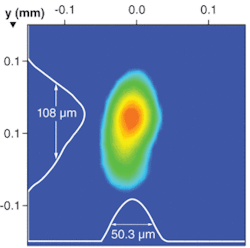DIODE-PUMPED LASERS: Femtosecond pulses reach terawatt power via Yb:CaF2

Lasers at terawatt (1012 W) powers have potential for all kinds of interesting new physics, but the systems are bulky, inefficient, and plagued by the difficulty of managing the heat without melting the optics (see www.laserfocusworld.com/articles/318551). To push the boundaries of high-power laser science toward resolving these problems, German researchers have for the first time used ytterbium calcium fluoride (Yb:CaF2) as an amplifying medium to demonstrate a diode-pumped, chirped-pulse laser amplifier system with a terawatt output.1
Mathias Siebold and colleagues at the Friedrich Schiller University (Jena, Germany) and the Max Planck Institute of Quantum Optics (Garching, Germany) used a direct-diode-pumped scheme, unlike previous approaches that required frequency doubling. “Other lasers have achieved petawatt output,” says Siebold, “but nearly all of them are flash-lamp pumped. Our system is all-direct-diode pumped, and has achieved record power for such a system.”
Due to a low quantum defect, broad gain spectrum, and long fluorescence lifetime, ytterbium-doped gain media are ideal for high-power, diode-pumped systems that require high optical efficiency. But only recently has Yb:CaF2 been grown in its single-crystalline form in large-enough formats to accommodate the centimeter-size apertures of high-energy short-pulse lasers.2 The Institute for Crystal Grown (Berlin, Germany) and the Institute of Optics and Fine Mechanics (Shanghai, China) provided cylindrical Yb:CaF2 crystals 28 mm long doped with Yb3+ and given an antireflective (AR) coating at the target infrared wavelength of 1031 nm.
The researchers used a Ti:sapphire oscillator to generate seed pulses of 85 fs (full width half maximum, or FWHM) in duration. A 14-in.-wide gold grating comprised a four-pass pulse stretcher that stretched the 1031 nm pulses to 2 ns in duration. A regenerative Yb:glass amplifier then boosted the seed pulses to an energy level of 40 mJ. Two stacks of 25 diode-laser bars pumped the configuration at a peak output power of 3.5 and 3.9 kW, respectively. A tiled grating compressor of four gold gratings was used to recompress the chirped pulses. Next, a spherical lens with a 5 m focal length focused the beam to correct far-field distortion of the output. After recompression, the researchers measured a maximum output pulse energy of 197 mJ for each pulse of 191 fs (FWHM).
In experiments using nanosecond pulses, a maximum pulse energy of 905 mJ was obtained with no optical damage, corresponding to a peak output fluence of 3.1 J/cm2. But at nanosecond pulse lengths, the AR coating sustained laser-induced damage at 956 mJ. Microsecond pulses produced an output pulse energy of 1.54 J (or 15.4 kW peak output power). This corresponds to a peak output fluence of 4.9 J/cm2. The optical-to-optical efficiency of nanosecond pulses was 3.9%, while the chirped-pulse amplification scheme achieved only 1.4% efficiency. While that sounds low, say the researchers, the Yb:CaF2 terawatt prototype has a lot of potential to be scaled up and optimized.
Although military and defense are obvious applications, if scaled to 1 PW the laser could be used in ion acceleration for cancer therapy, says Siebold.
REFERENCES
- M. Siebold et al., Opt. Lett. (online preview), posted (Oct. 21, 2008).
- A. Lucca et al., Opt. Lett. 29, 2767 (2004).
About the Author
Valerie Coffey-Rosich
Contributing Editor
Valerie Coffey-Rosich is a freelance science and technology writer and editor and a contributing editor for Laser Focus World; she previously served as an Associate Technical Editor (2000-2003) and a Senior Technical Editor (2007-2008) for Laser Focus World.
Valerie holds a BS in physics from the University of Nevada, Reno, and an MA in astronomy from Boston University. She specializes in editing and writing about optics, photonics, astronomy, and physics in academic, reference, and business-to-business publications. In addition to Laser Focus World, her work has appeared online and in print for clients such as the American Institute of Physics, American Heritage Dictionary, BioPhotonics, Encyclopedia Britannica, EuroPhotonics, the Optical Society of America, Photonics Focus, Photonics Spectra, Sky & Telescope, and many others. She is based in Palm Springs, California.
